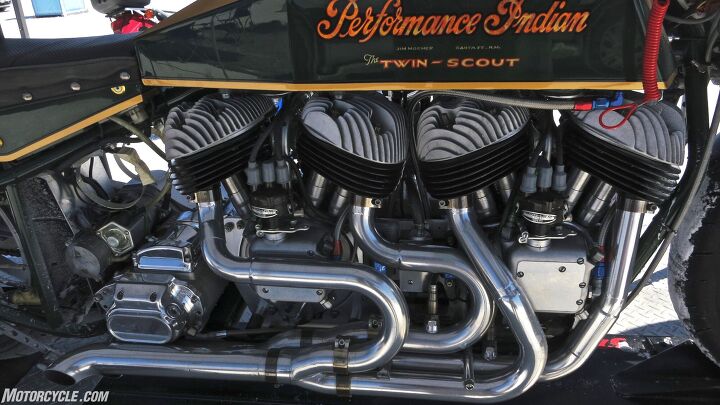
Gresh’s story on Bonneville appears today in Motorcycle.com! You can read it here!
Motorcycles, Scooters, Guns, Adventures, Opinions, and More

Gresh’s story on Bonneville appears today in Motorcycle.com! You can read it here!
It’s weird, I know, but I usually get the pre-ride jitters on every big motorcycle ride I’ve ever done. This time, I’m going into Mexico, back into the US, across the US from our southern border with Mexico to our northern border with Canada and then on up into Canada, and then back across the US to arrive home after riding roughly 4500 miles on the 2019 Three Flags Classic. The weird thing this time is I’m not apprehensive at all. I can’t wait to get started on this ride.
 I was able to hook up BajaBound Insurance with the Southern California Motorcycle Association and they are now the recommended insurers for the Mexico leg of this trip (hey, that’s what happens when you advertise with ExhaustNotes), and I’m going to get my insurance as soon as I’m done with this blog.
I was able to hook up BajaBound Insurance with the Southern California Motorcycle Association and they are now the recommended insurers for the Mexico leg of this trip (hey, that’s what happens when you advertise with ExhaustNotes), and I’m going to get my insurance as soon as I’m done with this blog.
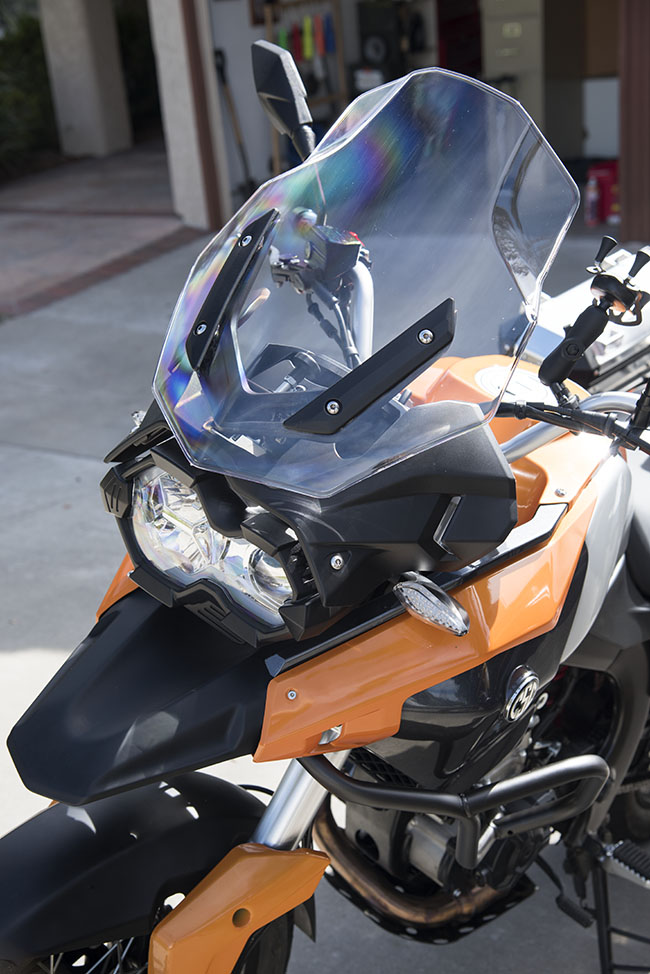 The CSC RX4 I wrote about earlier is running like a champ, and the guys at CSC Motorcycles have done a super job prepping the bike for me. There really wasn’t too much to do…I asked for the big Tourfella bags so I can carry my Nikon and my laptop to give you folks all the great photos and blogs you’re used to seeing on any ExNotes ride, a mount for my cellphone, and a set of running lights. I could have done without the running lights (you know, the spotlights) because the headlight on the RX4 is so good, but don’t tell CSC I told you. You should buy the spotlights anyway. They look cool.
The CSC RX4 I wrote about earlier is running like a champ, and the guys at CSC Motorcycles have done a super job prepping the bike for me. There really wasn’t too much to do…I asked for the big Tourfella bags so I can carry my Nikon and my laptop to give you folks all the great photos and blogs you’re used to seeing on any ExNotes ride, a mount for my cellphone, and a set of running lights. I could have done without the running lights (you know, the spotlights) because the headlight on the RX4 is so good, but don’t tell CSC I told you. You should buy the spotlights anyway. They look cool.
Man, I am looking forward to this one. I’m going to make new friends and see new sights. I can’t wait to meet the other 249 Three Flags Classic riders. And I’m going to do it all on the first RX4 in North America. It’s going to be great.
 It seems like tents get larger the more time they spend exposed to sunlight. But the thing is, man, camps were made to be broken. As much as I liked the hot sun, dusty gravel lot and 4-mile walk to the KOA facilities, we had to go.
It seems like tents get larger the more time they spend exposed to sunlight. But the thing is, man, camps were made to be broken. As much as I liked the hot sun, dusty gravel lot and 4-mile walk to the KOA facilities, we had to go.
I’m good with the two days we spent on the salt. I feel like we got a really good idea of the situation and the Southern California Timing Association had their hands full. They didn’t need me prowling around stirring up the troops. The salt was in no mood to be trifled with and we left it to bake and heave, a different salt from a few hours ago and different from that salt in a few more hours.
There’s no good route east from Bonneville except for the hard slog on Interstate 80. From there it’s a long hot day south and the Husky beat out a steady tune all the way to Moab, Utah. The place was an endless parade of tourists, every one one of them healthier than the last. Their bodies were so chiseled they looked like they subsisted solely on finely ground pumice. Their smiles were stretched over perfectly dazzling teeth. I felt like Quasimodo lurching among this mob of Fits.
 We swung through Monticello, Utah, a place where 11 years ago me and Hunter left Dave at a motel room with a broken foot and two hamburgers on his night stand. The past days and present days are crashing together on this ride. If you let your mind wander it’s easy to lose track of where you are on the continuum. The hamburger place where we stocked Dave’s nightstand is still there. Maybe Dave is still in that room. 11 years has gone-and-went representing one tiny tremor of time. What happened?
We swung through Monticello, Utah, a place where 11 years ago me and Hunter left Dave at a motel room with a broken foot and two hamburgers on his night stand. The past days and present days are crashing together on this ride. If you let your mind wander it’s easy to lose track of where you are on the continuum. The hamburger place where we stocked Dave’s nightstand is still there. Maybe Dave is still in that room. 11 years has gone-and-went representing one tiny tremor of time. What happened?
I rode away from Monticello on Godzilla back then. It was a hard pull up the grades. Sometimes the old two stroke held 55 mph. Now I rip up the same hills with the Husky spinning free. So much air pumping past 500 CC’s of modern 4-strokery. I’d still rather be on Godzilla. You earned a hill with that bike, man.
Tonight we’re giving Switchblade, the panhandler with a pickle, another shot at my ribcage in Window Rock. I wonder when I will be back to remember this place, to remember Switchblade. I wonder what the last place will be?
Get it while you can, boys.
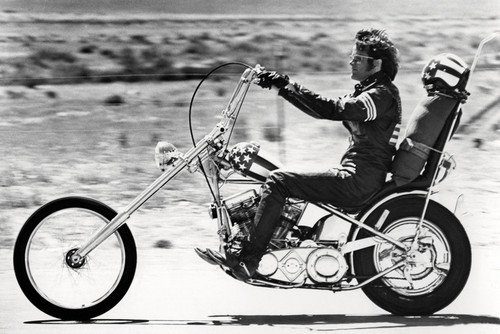 All good things must come to an end, I guess, and Peter Fonda’s life was a good thing that ended earlier today. It was too soon. He reached the ripe old age of 79, which is more than most, so in one sense I guess you could say he got his money’s worth. But it would have been better if he could have stayed longer. I liked the guy.
All good things must come to an end, I guess, and Peter Fonda’s life was a good thing that ended earlier today. It was too soon. He reached the ripe old age of 79, which is more than most, so in one sense I guess you could say he got his money’s worth. But it would have been better if he could have stayed longer. I liked the guy.
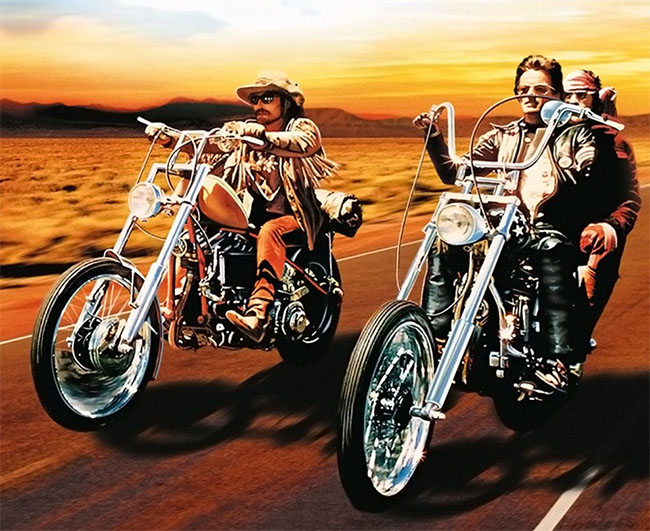 Peter Fonda first entered my life with the release of Easy Rider, a movie that hit the silver screen when I was a goofy teenager. Choppers entered the scene through that movie for me, and Wyatt was a character I think most guys my age wanted to be at one point or another in their lives. Billy, not so much. It was Jack Nicholson’s big break, and the movie put the idea of long distance motorcycle riding in many of our minds. It spawned a cultural and seismic shift in how most folks viewed motorcycles. It launched a motorcycle magazine of the same name where my short stories would later appear (yeah, I wrote short stories for Easy Riders back in the day). Easy Rider, the movie, by any measure was a big deal.
Peter Fonda first entered my life with the release of Easy Rider, a movie that hit the silver screen when I was a goofy teenager. Choppers entered the scene through that movie for me, and Wyatt was a character I think most guys my age wanted to be at one point or another in their lives. Billy, not so much. It was Jack Nicholson’s big break, and the movie put the idea of long distance motorcycle riding in many of our minds. It spawned a cultural and seismic shift in how most folks viewed motorcycles. It launched a motorcycle magazine of the same name where my short stories would later appear (yeah, I wrote short stories for Easy Riders back in the day). Easy Rider, the movie, by any measure was a big deal.
Fast forward a year or two, and it was a 750 Honda for me. I didn’t have the panhead Harley chopper, but I bought me a Captain America helmet and I was (at least in my mind) as cool as Peter Fonda. I wore that helmet on a motorcycle ride to Montreal. It’s all about the look, and I had it.
Fast forward a lot of years, and one day I was leaving Glendale Harley Davidson after stopping there to pick up a part and Peter Fonda was walking up the sidewalk as I was leaving. I said hi and he said How’s it going, man. It was a chance encounter I remember like it happened 10 minutes ago. He would have been in his mid-50s then, and I told everyone I knew for weeks after that I had seen Peter Fonda in person. I like to think that he told everyone he knew for weeks after that he had seen Joe Berk in person, but that was before I started writing the blog so deep in my heart I knew he probably didn’t. But for one brief instant we were equals: Peter Fonda nodded at me and asked How’s it going, man, like he had known me all his life. You can’t put a price on that.
Ride easy, Mr. Fonda. Thanks for the memories. And to answer your question, it’s going well, thank you, in no small part due to the influence you’ve had on many of us.

The rough wet salt did not bode well for the speed trials this year. After seeing how the situation unfolded yesterday Mike and I were in no hurry to get out to Bonneville and in fact it was almost 11:00 a.m. before we paid the SCTA man another $20 entrance fee.
The ticket man told us to avoid the start area as it was getting churned up and the competitor’s vehicles were getting stuck. It was kind of a pain because the start area was where we wanted to go. One thing I’ve learned in my short life is that there’s no sense in railing against mushy salt.
My hamburger-stand-at-noon meter told me there were fewer spectators and contestants than yesterday. Bonneville isn’t spectator friendly to start with as the courses are far in the distance. You pay to be surrounded by the ambiance: great things are happening just over the horizon.
The pits are very open, you can go bug the racers all you like. They really seemed to appreciate my helpful suggestions for grabbing that final 1/10 of a mile per hour.
I don’t know why my motorcycle brothers were being so obtuse on the track today. They consistently failed to clear off the course after their run much to the dismay of the hundreds of waiting competitors.
Even without the motorcycle guys gumming up the works wait times between runs stretched to 15 minutes. Multiply that by 100 or more competitors and you start to get at the immensity of the problem caused by Mother Nature shutting down three courses.
Bonneville is one of those events where it’s easier to compete in than spectate. After one really lengthy pause in the action we decided that racing may be over for the day. We headed back to camp feeling ill-used for our $20 entrance fee but it all goes to a good cause: The pursuit of speed.
Unrelated to anyone’s efforts on the salt, one of the bolts holding the luggage rack to the Husqvarna had fallen out somewhere on the trip to Bonneville. I removed the opposite side bolt for a sample and took the thing to Ace Hardware where they had no metric bolts. The next place I tried, CarQuest, had two of the small, 4mm bolts.
As soon as I located the correct bolts I should have known I was in trouble. The Husky uses those captivated-nut type of deals where a threaded nut is crimped into the aluminum frame tube. It gives you something sturdy and steel to screw into.
 When the sample bolt was removed the captivated nut became a free range nut and it wandered off into the frame tube. Of course I had no idea any of this was happening.
When the sample bolt was removed the captivated nut became a free range nut and it wandered off into the frame tube. Of course I had no idea any of this was happening.
I kept trying to screw the sample bolt back onto the Husqvarna. The thing would not start. As I became more confused I became more irrational. It was hot, Mike was making suggestions and I was not wanting to hear them: “I just took the bolt out of the F-ing rack minutes ago! Why won’t it start?” Semi-blind from sweat I removed everything off the back of the bike and it became clear that the bolt was never going to thread into the hole because there was nothing to thread into. It was a void, man.
 Back to Ace hardware for a $35 drill motor, a $14 drill bit set, and assorted 1/4″-20 bolts and nuts. That bastard rack was going to be secured by any means necessary. I drilled all the way through the frame tube and into the plastic inner fender. Now the longer bolt was slotted through into a locknut on the other side.
Back to Ace hardware for a $35 drill motor, a $14 drill bit set, and assorted 1/4″-20 bolts and nuts. That bastard rack was going to be secured by any means necessary. I drilled all the way through the frame tube and into the plastic inner fender. Now the longer bolt was slotted through into a locknut on the other side.
This all sounds simple but it took three separate trips to the auto store and hardware store to achieve. I gave Mike the new drill motor hoping the shiny bauble would make him forget all that he had seen earlier. I spent the remains of the day sitting by the KOA swimming pool and drinking gin & tonics. Tomorrow we break camp and start heading back to God’s country: New Mexico.
Hey, you! Yeah, you! Sign up for our automatic email blog updates!
Like Gresh’s writing? Yep, most of us do. Check out a few of Joe Gresh’s other articles here!
 A Ukrainian guy crashed his 900-volt electric bike at 150 miles per hour. He’s okay but the bike is a bit bent. It’s been a hard day on the salt for motorcycles and not much better for the cars. The course is rough and soft.
A Ukrainian guy crashed his 900-volt electric bike at 150 miles per hour. He’s okay but the bike is a bit bent. It’s been a hard day on the salt for motorcycles and not much better for the cars. The course is rough and soft.
I hear the grumbling as I cruise the pits. “No records this year.” “We might as well go home.” “They should call the whole thing off.” Conditions have restricted the racers to one course for experts and one course for rookies. At the start area the blue course lines are close together and they get wider apart the further down course you go.
 A Buell rider was 5th from the start line when racing was called for the day. He’d been in line since 7:00 a.m. and the line is a mile long. It takes patience to go fast.
A Buell rider was 5th from the start line when racing was called for the day. He’d been in line since 7:00 a.m. and the line is a mile long. It takes patience to go fast.
The Bonneville speed trials are spread out over 8 miles. There are thousands of rebars pounded into the salt and miles of yellow plastic tape denoting areas but it all seems so random. We ride over and under the tape. No one bothers us. The tape is just to give your mind something to work on in the featureless white plains. Mostly the pit area is near the middle and the course is a quarter mile away. Bring binoculars or all you’ll see is a tiny object speeding from your right to your left.
 Walking the pits is a 6-mile proposition. It’s huge and the blinding white salt burns your skin from underneath. You really need two hats: one on top as normal and one with the center cut out and the brim circling your neck like a Queen Elizabeth collar.
Walking the pits is a 6-mile proposition. It’s huge and the blinding white salt burns your skin from underneath. You really need two hats: one on top as normal and one with the center cut out and the brim circling your neck like a Queen Elizabeth collar.
The place is solid enough where compacted. Out towards the edges and further north the salt gets crunchy and damp. It feels like the water table is a few inches down.
2:30 p.m. and racing is over; spectators and racers wander away from the salt in dribs and drabs. It’s a slow exodus with a heavy flat head V-8 feel to it.
 Old Salts tell me attendance is down this year but that guy who waited all day for his run thinks that there are plenty of people. I’m a rookie so it looks fine to me.
Old Salts tell me attendance is down this year but that guy who waited all day for his run thinks that there are plenty of people. I’m a rookie so it looks fine to me.
The track radio announcer who is from the Upper Peninsula of Michigan is also in charge of the Porta Potties. There are 74 plastic potties spread around the 8 miles. I told him number 68 out by Mile Marker 7 was not sitting level and could he shim the thing properly. He wants to set a record with a ZZR Kawasaki but has run out of money. Announcing is a slow business with 75% of the track closed but he makes a good job of keeping it interesting.
I met a chick with a turbo CB125 Honda. She was in the empty impound area where the record setters await a second pass to make it official. She said the track was rutted and bumpy but she managed 57 miles per hour. Somehow that was a record. The soft salt sucks power. It’s like racing through sand.
On the ride back to town you’ll pass hundreds of campers parked alongside the road. It’s a free camp area but the facilities are zero. It’s primitive but for the guys watching TV in motorhomes it all looks the same.
My buddy Old Iron says that to find a good restaurant in West Wendover look for salt in the parking lot. The more salt, the better. If there’s a turbine powered car parked up you’re golden. It works, my brothers.
 West Wendover, Nevada.
West Wendover, Nevada.
Where else can you find an old flathead Ford Hot Rod and a 27-foot long turbine powered Liner parked up at the cafe?

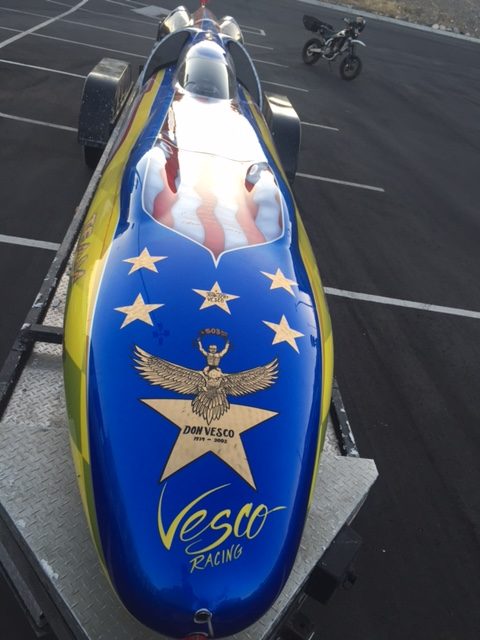 So many talented builders are in Bonneville. The trailers are works of art, their suspensions complex links and air bags. It’s like a superior race of mechanics from another planet has landed on Earth.
So many talented builders are in Bonneville. The trailers are works of art, their suspensions complex links and air bags. It’s like a superior race of mechanics from another planet has landed on Earth.
We can’t go a block in the mini-casino town of West Wendover without stumbling on something cool, something Rod-ish.
 Right now, in this town, the combined brain power could accomplish any task. And it would be accomplished with glossy paint and many, many holes drilled for light weight.
Right now, in this town, the combined brain power could accomplish any task. And it would be accomplished with glossy paint and many, many holes drilled for light weight.
Salt is everywhere. The cars are covered in it. It falls off in fist-sized chunks and then the salt chunks are pulverized by passing cars.
But back to camping: my tent has changed shape in the 6 years since I last propped the thing up. The poles are all the wrong length and I’m pretty sure you’re not supposed to cut large sections out of the walls to assemble the thing.
The tent is standing but it looks more like a pile of dirty laundry rather than a house. All these geniuses surrounding me. How do I tap into that knowledge?
The Husky is getting a bit cranky. At low speeds It’s stalling frequently. The clutch is dragging a bit and with no flywheel the thing will just pop and die. I think I’ll check the intake manifold rubber for tightness.
Had a great dinner at the Prospector Cafe: fried chicken with salad, bread and iced tea, cheeseburger and a Modelo dark beer totaled $20. A guy could get used to casino living.
 Caliente, Nevada.
Caliente, Nevada.
I moved my camping gear 510 miles today. The longest I’ve had to endure the Husqvarna’s ridiculous seat. I feel like the monk in that old joke.
This was the longest day. We covered a lot of miles so that tomorrow’s ride into camp will be short and sweet, leaving us plenty of time to ponder how the tent goes together.
Caliente is shut down. Nothing is open, the road into town is lined with old railroad cabins. The cabins are restored, Some people would call them cute. I see hard work. In a land of space, where the view goes on forever, the cabins are only feet apart. It must have felt safer together against the huge West. Tracks run behind the cabins rattling doors and windows. Man, I can sleep right through that sound.
So many elevation changes and temperature variations on the road. You can feel agriculture. The spot humidity rises, a quarter mile of cold runs alongside dark green crops, all alive against the tan dirt. And then you are back in the desert. Warm, dry air fills the road. I can look ahead and predict the local weather.
On the long days there’s not much human interaction. Ride, gas, ride, gas. Repeat over and over, each fill up is 150 miles of seat time. The long passages give you a lot of time to think great thoughts, maybe a new idea for land terracing or a way to move 60-lb bags of concrete more efficiently. I thought about the Husqvarna seat.
Did I mention the seat? Because it’s all I think about. It’s a major player in my dreams and nightmares. I imagine the seats in hell are shaped like the Husqvarna thing-between-the-frame-and-your-butt.
What are the odds? The guy running our motel wants to build one of those bicycle motor things. I kid you not. I whipped out cell phone photos of Huffenstein and we both got excited about the project, me for the second time. I’m sure he’s gonna buy a motor.
Bonneville tomorrow!

 Window Rock, Arizona.
Window Rock, Arizona.
I thought the guy behind us was yelling at the black SUV. The SUV drove on but the guy kept yelling. Strange garbled words, some Navajo, some English, it was difficult to say if he was angry. He was smiling all the time.
The words kept pouring out as he bumped into me, wanting to shake hands. He didn’t care for the standard handshake and performed a fist bump/hand wrestling sort of ritual. All the while speaking fast, using unrelated words to string together ideas in an almost-sentence way.
I started to pick up a few bits of the conversation: He called me the N word, but in a nice, brotherly way. At least I think it was brotherly. Then he said that I was in his town then some vague broken bits about cutting people with a knife. “What language are you speaking?” I asked him. “It doesn’t matter,” he said to me and then showed me his drivers license. He was from Arizona.
Tall and good-looking, the guy may have been a great warrior chief in an earlier time. Now, he wanders parking lots jabbering at people in a confused muddle, his skill set woefully out of sync with life in 2019 America.
The guy kept stumbling into me, by accident or by design. It was annoying but he seemed happy as he asked me if I’d like to be stabbed and thrown into a ditch. It was the most non-threatening threat ever. Was he serious? There were a lot of ditches around. I made a mental note to start looking down for bodies.
It dawned on me that the guy was completely bonkers and then he asked me for two dollars. “That’s F-ed up, man,” I told him “I don’t want to be cut and thrown into a ditch.” He didn’t seem surprised at my refusal; I’m guessing his unorthodox panhandling method turns off a lot of potential marks.
We went into the only place open in town, a Taco Bell, the glass door 0f the Taco Bell seemed to frighten him and he drifted away towards the street. Still happy and still wanting to kill someone.
The rain started around 3:00 p.m. and kept a steady pace. It was a cool, 54-degree August day in northern New Mexico. So much different than the hot, dry morning. Now we were marooned with just enough gas in the Husqvarna to make 10 miles. The next town was 20 miles away.
I was waiting at a liquor store/gas station that had no electricity for Mike to return with a can of gas. Mike’s BMW can go 200 miles on a tank. The Husky taps out at around 150 miles. From my perch under the store awning I saw 700 to 800 cans of beer get sold in a few hours. Skinny people, fat people, old people, young people, no one bought less than 48 cans. They carried the stuff out by the armload. Thank goodness the cash register was on battery backup.
The power would come on and I’d run out to the pump then the power would go off. This happened about 20 times. One of the liquor store staff was an adorable woman complaining about menopause: “You don’t know what it’s like, one minute you’re fine, the next you’re on fire!” The power sputtered. All of us, customers and staff, started yelling, “Lights on! Lights off!” in synchronization with the flickering power.
“Would you like a hotdog? Free, I won’t charge you for it. They’re still kind of warm but we have to throw out the hot foods after a few hours of no power.” What a nice bunch of people. Free hot dogs, all the beer you could fit in a trunk, we had a good time, you know?
“Your friend has a funny accent.” said Menopause Woman. “Where is he from?”
“New Jersey, or somewhere back east,” I told her.
“I suppose he thinks we sound funny too,” she said in that rising, musical New Mexican lilt I’ve come to love.
Mike came back with the gas, we dumped it into the Husqvarna and lit the bikes off. Into the rain we motored on. Gasoline is freedom, man. About 10 miles later we saw a lineman sitting in his truck, rain pouring down. For all I know the power never came back on back at the store. The lives we shared at that place didn’t matter to us anymore, we were back on the road.
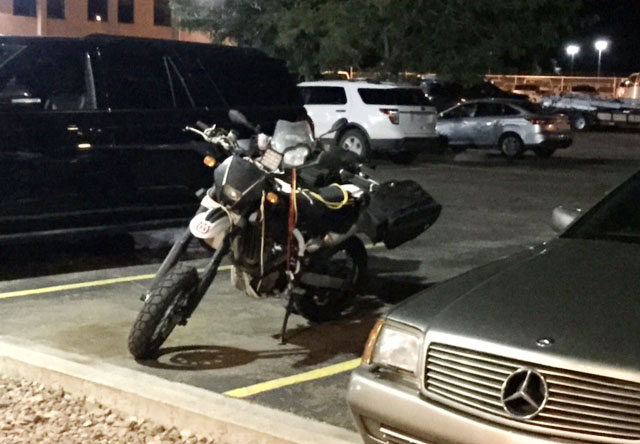
Here’s another great day from the Western America Adventure Ride back in 2015 when we rode across the US with our guests from China and Colombia. It was an interesting day for many reasons, but what happened in Carey, Idaho, will stay with me for a long time.
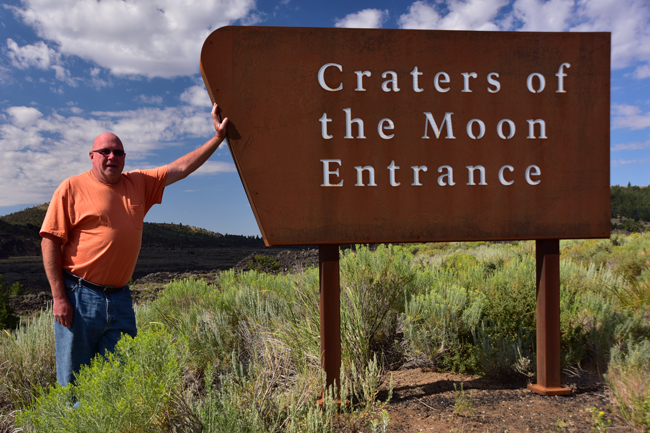
We had left the Craters of the Moon (a National Monument in the middle of nowhere in Idaho) earlier that morning and ridden another 50 miles or so (with literally nothing in between except open plains, rolling hills, and beautiful scenery) when we entered Carey. You have to understand that Carey is basically a wide spot in the road with maybe 40 or 50 buildings along the way. I was focused on getting there, filling the bikes, and getting back on the road.
When we pulled into Carey, it was like my home town in the early afternoon on the 4th of July. You know, everybody was sitting on lawn chairs, lining the street, waving American flags, and waiting for the parade. That’s literally what we encountered. The good citizens of Carey were waiting for the parade, except it wasn’t the 4th of July.
Gresh and I were leading the pack at about 15 miles an hour when we rode into town, and everybody starting cheering and waving when they saw us. We didn’t know what was going on. I had been blogging every night and Gresh had been kidding me about that. Gresh lifted his face shield and looked at me while we were still rolling. “Boy, a lot of people are following the blog,” he said.
Okay, so we rolled into town on our RX3s. All of us, on RX3 motorcycles, with the town cheering. You can guess where this is going…the good people of Carey thought we were the start of the parade. The Carey people waved and welcomed us. What the Chinese and the Colombian guys were thinking I can only guess.
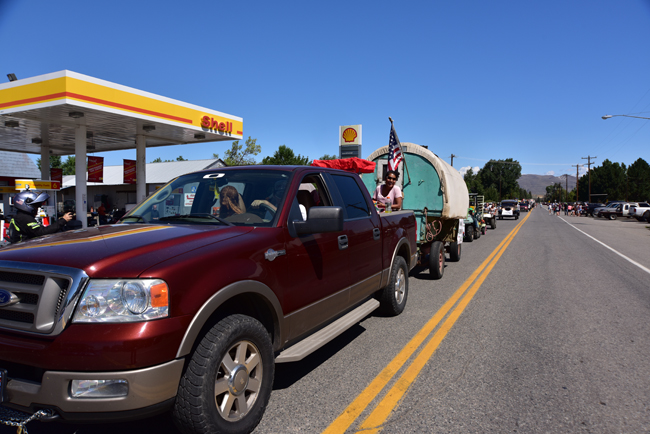
We pulled into a Shell station (the only one in town). I wanted to get gas and get going. I went into the station and asked what was going on. The girl behind the counter looked at me like I was crazy. I didn’t know it, but it was Pioneer Day in Idaho. It’s a holiday they take very seriously. I imagine everybody in town was out there on both sides of the street.
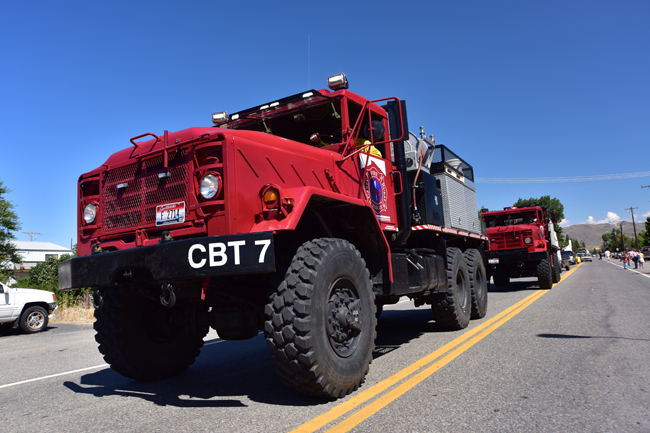

Like I said, I wanted to get gas and get out of town before the parade hit. The Chinese guys and the Colombians wanted to stay and watch the parade.
You can guess which way it went.
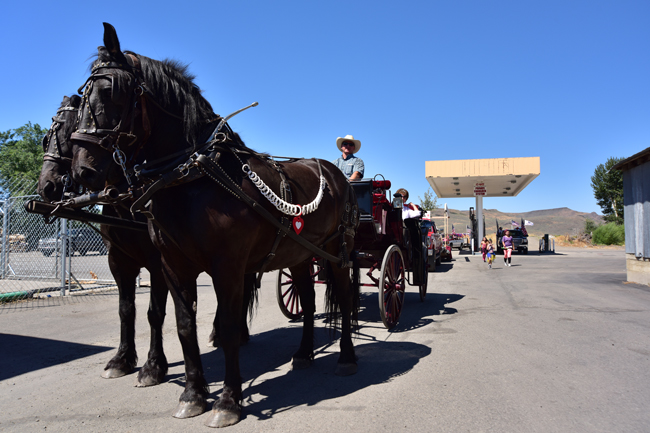
We had a pretty good time in Carey. Our Chinese and Colombian visitors were seeing a good old fashioned American parade, and the good folks in Carey met folks from the other side of the world. I can only imagine the stories our visitors took home. I sure landed a good story to share with you!
Want to read more about our Epic Rides? Just click here!